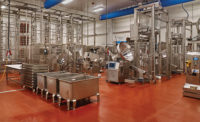Keeping organic food safe through proper sanitation

When people are shopping for produce, they might consider buying organic food because of its eco-friendly and health-conscious qualities. However, they may be misunderstanding the term organic as “clean” or “safe.” Pathogens, after all, don’t discriminate between organic and conventional produce, so even though it might have certain qualities, organic produce can present a food safety risk.
Growers, packers, processors, shippers, and retailers all have a role in ensuring the safety of produce from the farm to the consumers plate. Everyone who handles fresh produce needs to understand the potential safety risks associated with the food they are handling and take appropriate steps to keep the product safe. However, produce packers and processors, including fresh cut and IQF operations, have a key role in this responsibility.
How do organic processors ensure their food is safe?
Wash water sanitizers, safe handling procedures and proper sanitation products and processes are some of the solutions processors use to ensure the safety of fresh produce. Wash water sanitizers such as sodium hypochlorite, sodium chlorite solution (acidified with citric acid) and peroxyacetic acid products are all suitable for use in organic processes and products.
However, sanitation isn’t just about the products that processors use in contact with food. Organic processing facilities have to be thoroughly cleaned and sanitized as well, and there are some limitations on the chemicals that can be used if they want to retain their organic status. Organic certifiers will require that the final sanitation step uses National Organic Program approved sanitizers and ensure that other cleaners do not contaminate raw materials, product or packaging.
While the steps required to maintain organic certification and meet the necessary food safety standards might seem tedious, it’s far worse to experience contamination in your facility or send contaminated product into commerce. That could lead to a recall, resulting in substantial direct losses and ongoing damage to your reputation and profitability. Ultimately, organic produce processors must determine the best way to balance certification and effective food safety. Decisions concerning both have the potential to impact their brand’s reputation.
Doesn’t the use of chemicals contradict the term “organic”?
The National Organic Program (NOP) List of Allowed and Prohibited Substances lists four types of chemicals as being suitable as organic facility sanitizers: sodium chlorite solution (acidified with citric acid); chlorine materials, including calcium hypochlorite, chlorine dioxide and sodium hypochlorite; ozone; and peroxyacetic acid. Conventional facility sanitizers such as quats or quaternary ammonium sanitizers are not allowed when organic products are being produced.
When it comes to produce, half of U.S. consumers say they are most likely to buy organic fruits and vegetables. And while those consumers might think organic simply means picked off the vine and served, it’s certainly more involved than that. Sanitation keeps our food safe for consumption and helps reduce the spread of food borne illness. Whether organic or conventional, sanitation of both food and facility is a critical part of the food supply chain.
Looking for a reprint of this article?
From high-res PDFs to custom plaques, order your copy today!






